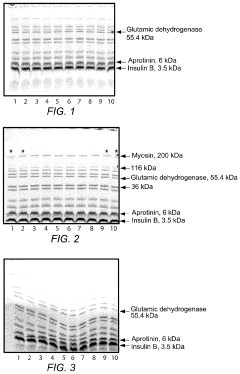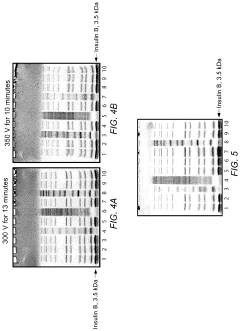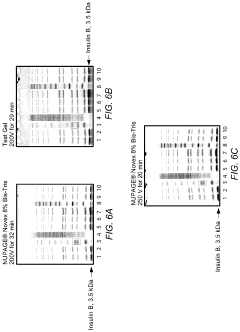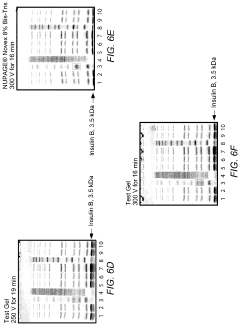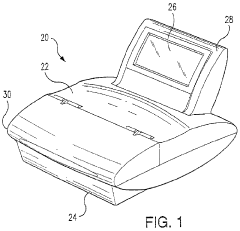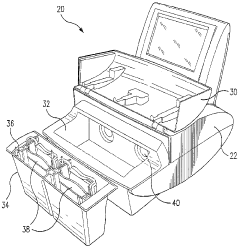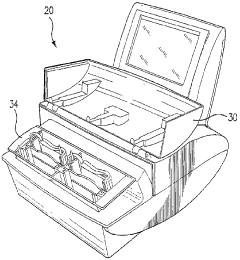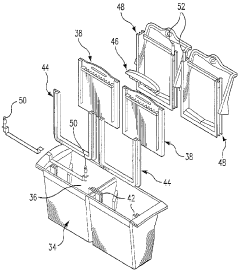Gel Electrophoresis: Techniques for Enhancing Precision
JUN 30, 20259 MIN READ
Generate Your Research Report Instantly with AI Agent
Patsnap Eureka helps you evaluate technical feasibility & market potential.
Gel Electrophoresis Evolution and Objectives
Gel electrophoresis has evolved significantly since its inception in the 1930s, becoming a cornerstone technique in molecular biology and biochemistry. Initially developed for protein separation, it has expanded to encompass nucleic acid analysis, playing a crucial role in genomics and proteomics research. The technique's evolution has been driven by the need for increased precision, resolution, and efficiency in separating biological molecules.
The primary objective of gel electrophoresis is to separate molecules based on their size and charge, allowing researchers to analyze complex mixtures of biomolecules. Over the years, the focus has shifted towards enhancing the precision of this separation process. This has led to the development of various types of gels, buffer systems, and electrophoresis apparatus, each tailored to specific applications and molecule types.
One of the key milestones in gel electrophoresis was the introduction of polyacrylamide gels in the 1950s, which significantly improved resolution for protein separation. The 1970s saw the advent of agarose gels for DNA separation, revolutionizing molecular biology research. Subsequently, the development of pulsed-field gel electrophoresis in the 1980s enabled the separation of much larger DNA fragments, expanding the technique's capabilities.
Recent technological advancements have focused on miniaturization, automation, and integration with other analytical techniques. Microfluidic devices and capillary electrophoresis systems have emerged, offering higher throughput and reduced sample requirements. These innovations aim to address the growing demand for rapid, high-precision analysis in fields such as genomics, proteomics, and clinical diagnostics.
The current objectives in gel electrophoresis research revolve around further enhancing precision, sensitivity, and reproducibility. This includes developing novel gel matrices with improved separation properties, optimizing buffer systems for specific applications, and integrating advanced detection methods such as fluorescence and mass spectrometry. Additionally, there is a push towards more environmentally friendly and cost-effective electrophoresis techniques, addressing the sustainability concerns in laboratory practices.
As the field of molecular biology continues to advance, gel electrophoresis techniques are evolving to meet new challenges. The integration of artificial intelligence and machine learning algorithms for data analysis and interpretation is becoming increasingly important. These tools aim to enhance the accuracy of molecular weight determination and quantification, further improving the precision of gel electrophoresis results.
The primary objective of gel electrophoresis is to separate molecules based on their size and charge, allowing researchers to analyze complex mixtures of biomolecules. Over the years, the focus has shifted towards enhancing the precision of this separation process. This has led to the development of various types of gels, buffer systems, and electrophoresis apparatus, each tailored to specific applications and molecule types.
One of the key milestones in gel electrophoresis was the introduction of polyacrylamide gels in the 1950s, which significantly improved resolution for protein separation. The 1970s saw the advent of agarose gels for DNA separation, revolutionizing molecular biology research. Subsequently, the development of pulsed-field gel electrophoresis in the 1980s enabled the separation of much larger DNA fragments, expanding the technique's capabilities.
Recent technological advancements have focused on miniaturization, automation, and integration with other analytical techniques. Microfluidic devices and capillary electrophoresis systems have emerged, offering higher throughput and reduced sample requirements. These innovations aim to address the growing demand for rapid, high-precision analysis in fields such as genomics, proteomics, and clinical diagnostics.
The current objectives in gel electrophoresis research revolve around further enhancing precision, sensitivity, and reproducibility. This includes developing novel gel matrices with improved separation properties, optimizing buffer systems for specific applications, and integrating advanced detection methods such as fluorescence and mass spectrometry. Additionally, there is a push towards more environmentally friendly and cost-effective electrophoresis techniques, addressing the sustainability concerns in laboratory practices.
As the field of molecular biology continues to advance, gel electrophoresis techniques are evolving to meet new challenges. The integration of artificial intelligence and machine learning algorithms for data analysis and interpretation is becoming increasingly important. These tools aim to enhance the accuracy of molecular weight determination and quantification, further improving the precision of gel electrophoresis results.
Market Demand Analysis for Precise Gel Electrophoresis
The market demand for precise gel electrophoresis techniques has been steadily increasing in recent years, driven by advancements in molecular biology, genomics, and proteomics research. This growth is particularly evident in the life sciences sector, where accurate separation and analysis of DNA, RNA, and proteins are crucial for various applications.
In the pharmaceutical and biotechnology industries, there is a growing need for high-precision gel electrophoresis methods to support drug discovery and development processes. These industries require more sensitive and reproducible techniques for analyzing complex biological samples, identifying potential drug targets, and assessing the efficacy of new therapeutic compounds.
The academic research sector also contributes significantly to the demand for enhanced gel electrophoresis techniques. As researchers delve deeper into understanding cellular processes and genetic mechanisms, they require more precise tools to separate and visualize biomolecules. This has led to an increased focus on developing improved gel electrophoresis methods that offer higher resolution and better quantification capabilities.
Clinical diagnostics represent another key market segment driving the demand for precise gel electrophoresis. With the rise of personalized medicine and molecular diagnostics, there is a growing need for accurate and reliable methods to analyze genetic markers, detect mutations, and identify disease-associated proteins. Precise gel electrophoresis techniques play a crucial role in these applications, enabling healthcare professionals to make more informed decisions about patient care and treatment strategies.
The food and beverage industry has also shown increasing interest in precise gel electrophoresis techniques for quality control and safety testing. These methods are used to detect food adulterants, verify product authenticity, and ensure compliance with regulatory standards. As consumers become more conscious about food safety and quality, the demand for accurate analytical tools in this sector continues to grow.
Environmental monitoring and forensic science are emerging areas that contribute to the market demand for precise gel electrophoresis. These fields require highly sensitive and specific techniques to analyze environmental samples, identify pollutants, and process forensic evidence. The ability to accurately separate and visualize complex mixtures of molecules is essential for these applications, driving the need for improved gel electrophoresis methods.
As the global research and development landscape expands, there is an increasing demand for gel electrophoresis equipment and consumables that offer enhanced precision and reproducibility. This has led to a growing market for advanced imaging systems, high-quality gel matrices, and specialized reagents designed to improve the overall performance of gel electrophoresis techniques.
In the pharmaceutical and biotechnology industries, there is a growing need for high-precision gel electrophoresis methods to support drug discovery and development processes. These industries require more sensitive and reproducible techniques for analyzing complex biological samples, identifying potential drug targets, and assessing the efficacy of new therapeutic compounds.
The academic research sector also contributes significantly to the demand for enhanced gel electrophoresis techniques. As researchers delve deeper into understanding cellular processes and genetic mechanisms, they require more precise tools to separate and visualize biomolecules. This has led to an increased focus on developing improved gel electrophoresis methods that offer higher resolution and better quantification capabilities.
Clinical diagnostics represent another key market segment driving the demand for precise gel electrophoresis. With the rise of personalized medicine and molecular diagnostics, there is a growing need for accurate and reliable methods to analyze genetic markers, detect mutations, and identify disease-associated proteins. Precise gel electrophoresis techniques play a crucial role in these applications, enabling healthcare professionals to make more informed decisions about patient care and treatment strategies.
The food and beverage industry has also shown increasing interest in precise gel electrophoresis techniques for quality control and safety testing. These methods are used to detect food adulterants, verify product authenticity, and ensure compliance with regulatory standards. As consumers become more conscious about food safety and quality, the demand for accurate analytical tools in this sector continues to grow.
Environmental monitoring and forensic science are emerging areas that contribute to the market demand for precise gel electrophoresis. These fields require highly sensitive and specific techniques to analyze environmental samples, identify pollutants, and process forensic evidence. The ability to accurately separate and visualize complex mixtures of molecules is essential for these applications, driving the need for improved gel electrophoresis methods.
As the global research and development landscape expands, there is an increasing demand for gel electrophoresis equipment and consumables that offer enhanced precision and reproducibility. This has led to a growing market for advanced imaging systems, high-quality gel matrices, and specialized reagents designed to improve the overall performance of gel electrophoresis techniques.
Current Challenges in Gel Electrophoresis Precision
Gel electrophoresis, a cornerstone technique in molecular biology, faces several challenges that impede its precision and reliability. One of the primary issues is inconsistent gel composition, which can lead to non-uniform migration of molecules. Variations in gel density, pore size, and overall structure can cause unpredictable separation patterns, making it difficult to accurately compare results across different experiments or laboratories.
Another significant challenge is temperature fluctuations during the electrophoresis process. Uneven heating can cause "smiling" or "frowning" of bands, distorting the migration pattern and compromising the accuracy of size estimations. This issue is particularly problematic in larger gels or when running at higher voltages, where heat generation is more pronounced.
Sample loading inconsistencies also pose a major hurdle in achieving high precision. Variations in sample volume, concentration, or the presence of contaminants can lead to irregular band formation and migration. This challenge is exacerbated when dealing with complex biological samples or when attempting to load very small volumes.
The resolution of closely sized molecules remains a persistent issue, especially for DNA fragments differing by only a few base pairs or proteins with similar molecular weights. Traditional gel electrophoresis techniques often struggle to provide the necessary resolution for these applications, limiting their utility in certain research contexts.
Staining and visualization methods present another set of challenges. Uneven staining can lead to misinterpretation of results, while some staining techniques may not be sensitive enough to detect low-abundance molecules. Additionally, the subjective nature of band intensity interpretation can introduce variability in quantitative analyses.
Reproducibility across different runs and laboratories is a pervasive issue, often stemming from a combination of the aforementioned challenges. Slight variations in gel preparation, running conditions, or sample handling can lead to significant differences in results, making it difficult to establish standardized protocols.
Lastly, the time-consuming nature of gel electrophoresis, particularly for high-resolution applications, limits its throughput and applicability in large-scale studies. This constraint becomes increasingly relevant in the era of high-throughput genomics and proteomics, where rapid and precise analysis of numerous samples is often required.
Addressing these challenges is crucial for enhancing the precision and reliability of gel electrophoresis, ensuring its continued relevance in modern molecular biology research and diagnostics.
Another significant challenge is temperature fluctuations during the electrophoresis process. Uneven heating can cause "smiling" or "frowning" of bands, distorting the migration pattern and compromising the accuracy of size estimations. This issue is particularly problematic in larger gels or when running at higher voltages, where heat generation is more pronounced.
Sample loading inconsistencies also pose a major hurdle in achieving high precision. Variations in sample volume, concentration, or the presence of contaminants can lead to irregular band formation and migration. This challenge is exacerbated when dealing with complex biological samples or when attempting to load very small volumes.
The resolution of closely sized molecules remains a persistent issue, especially for DNA fragments differing by only a few base pairs or proteins with similar molecular weights. Traditional gel electrophoresis techniques often struggle to provide the necessary resolution for these applications, limiting their utility in certain research contexts.
Staining and visualization methods present another set of challenges. Uneven staining can lead to misinterpretation of results, while some staining techniques may not be sensitive enough to detect low-abundance molecules. Additionally, the subjective nature of band intensity interpretation can introduce variability in quantitative analyses.
Reproducibility across different runs and laboratories is a pervasive issue, often stemming from a combination of the aforementioned challenges. Slight variations in gel preparation, running conditions, or sample handling can lead to significant differences in results, making it difficult to establish standardized protocols.
Lastly, the time-consuming nature of gel electrophoresis, particularly for high-resolution applications, limits its throughput and applicability in large-scale studies. This constraint becomes increasingly relevant in the era of high-throughput genomics and proteomics, where rapid and precise analysis of numerous samples is often required.
Addressing these challenges is crucial for enhancing the precision and reliability of gel electrophoresis, ensuring its continued relevance in modern molecular biology research and diagnostics.
Existing Precision Enhancement Techniques
01 Improved gel composition for electrophoresis
Advancements in gel composition can enhance the precision of gel electrophoresis. These improvements include the use of specific polymers, cross-linking agents, and additives that create a more uniform and stable gel matrix. This results in better separation of molecules and increased reproducibility of results.- Improved gel composition for electrophoresis: Advanced gel compositions are developed to enhance the precision of gel electrophoresis. These compositions may include specific polymers, cross-linking agents, or additives that improve resolution and separation of biomolecules. The improved gels can provide better band sharpness, reduced background noise, and increased overall precision in electrophoretic analysis.
- Enhanced detection and imaging techniques: Novel detection and imaging methods are implemented to increase the precision of gel electrophoresis results. These may include advanced fluorescence techniques, high-resolution cameras, or specialized software for image analysis. Such improvements allow for more accurate quantification of bands and detection of subtle differences between samples.
- Microfluidic and miniaturized electrophoresis systems: Miniaturized and microfluidic electrophoresis systems are developed to improve precision through reduced sample volumes and more controlled environments. These systems often incorporate advanced fabrication techniques and materials to create precise channels and structures for electrophoresis, resulting in higher resolution and reproducibility.
- Automated sample loading and running systems: Automation of sample loading and electrophoresis running processes is implemented to reduce human error and increase reproducibility. These systems may include robotic sample handlers, precise voltage controllers, and temperature regulation mechanisms to ensure consistent and precise results across multiple runs.
- Data analysis and interpretation software: Specialized software tools are developed for analyzing and interpreting gel electrophoresis results with high precision. These tools may incorporate machine learning algorithms, advanced statistical methods, or comparative databases to accurately identify and quantify bands, detect anomalies, and provide standardized interpretations of electrophoresis data.
02 Enhanced detection and quantification methods
Implementing advanced detection and quantification techniques can significantly improve the precision of gel electrophoresis. These methods may include fluorescent labeling, chemiluminescence, or digital imaging systems that allow for more accurate measurement of band intensity and position.Expand Specific Solutions03 Optimized buffer systems and running conditions
Developing specialized buffer systems and optimizing running conditions can lead to improved precision in gel electrophoresis. This includes adjusting pH, ionic strength, and temperature to achieve better resolution and reproducibility of results.Expand Specific Solutions04 Automated gel electrophoresis systems
Automation of gel electrophoresis processes can enhance precision by reducing human error and improving consistency. These systems may include automated sample loading, running, and analysis, leading to more reproducible results across multiple experiments.Expand Specific Solutions05 Microfluidic and miniaturized electrophoresis devices
Development of microfluidic and miniaturized electrophoresis devices can improve precision by reducing sample volumes and increasing control over separation conditions. These devices often incorporate advanced materials and fabrication techniques to achieve high-resolution separations in a compact format.Expand Specific Solutions
Key Players in Gel Electrophoresis Industry
The gel electrophoresis market is in a mature stage, with established techniques and a growing demand for precision enhancement. The global market size is estimated to be in the billions, driven by applications in research, diagnostics, and forensics. Technologically, the field is advancing with innovations in high-resolution systems and automation. Key players like Life Technologies Corp., Beckman Coulter, Inc., and Agilent Technologies, Inc. are leading the development of advanced gel electrophoresis solutions. These companies are focusing on improving accuracy, speed, and reproducibility of results, while also integrating digital technologies for data analysis and interpretation. The competitive landscape is characterized by ongoing R&D efforts to address the increasing demand for more sensitive and efficient electrophoresis techniques in various scientific disciplines.
Agilent Technologies, Inc.
Technical Solution: Agilent Technologies has developed advanced gel electrophoresis systems that enhance precision through automated sample loading and analysis. Their 2100 Bioanalyzer system utilizes microfluidic technology for high-resolution DNA, RNA, and protein analysis[1]. This lab-on-a-chip approach minimizes sample volumes and reduces manual handling errors. Agilent has also introduced the TapeStation systems, which automate electrophoresis processes, including sample loading, separation, imaging, and data analysis[2]. These systems employ pre-cast gels and standardized protocols to ensure reproducibility across experiments.
Strengths: High automation, reduced manual errors, and improved reproducibility. Weaknesses: Higher initial cost compared to traditional systems and potential limitations in customization for specialized applications.
F. Hoffmann-La Roche Ltd.
Technical Solution: Roche has innovated in gel electrophoresis precision through their LightCycler systems, which integrate real-time PCR with high-resolution melting analysis[3]. This approach allows for precise DNA fragment analysis without traditional gel electrophoresis. For protein analysis, Roche offers the Cedex Bio HT Analyzer, which utilizes capillary electrophoresis principles for high-throughput, high-precision protein quantification and characterization[4]. These systems employ advanced detection methods, such as fluorescence and UV absorbance, to enhance sensitivity and accuracy in biomolecule analysis.
Strengths: Integration of multiple analytical techniques, high sensitivity, and suitability for high-throughput applications. Weaknesses: Specialized equipment may have a steep learning curve and higher costs compared to traditional gel electrophoresis methods.
Innovative Approaches to Gel Electrophoresis Precision
System for rapid high-resolution GEL electrophoresis
PatentActiveUS20190391113A1
Innovation
- The development of electrophoretic systems and formulations that allow for higher field strengths up to 50% more than conventional systems, using a discontinuous buffer system with specific gel amine and ampholyte buffers, and a pH range of 5.5 to 7.5, enabling faster separation of proteins within 30 minutes or less, even at higher voltages.
Gel electrophoresis, imaging, and analysis methods, devices, systems, and materials
PatentWO2011025781A1
Innovation
- A gel electrophoresis device that integrates gel processing, image capture, and image analysis systems, allowing for automated performance of electrophoresis, real-time imaging, and simultaneous processing of multiple gels, with features like LED illumination and CMOS digital cameras for efficient data capture and analysis.
Standardization and Quality Control Measures
Standardization and quality control measures are crucial for enhancing the precision of gel electrophoresis techniques. These measures ensure reproducibility, reliability, and comparability of results across different laboratories and experiments.
One key aspect of standardization is the use of consistent protocols for sample preparation, gel casting, and running conditions. This includes standardizing buffer compositions, gel concentrations, and electrophoresis parameters such as voltage and run time. By adhering to well-established protocols, researchers can minimize variability and improve the consistency of their results.
Quality control in gel electrophoresis often involves the use of molecular weight markers or ladders. These standards allow for accurate size determination of DNA or protein fragments and serve as internal controls for each run. Implementing a system of regular calibration and validation of these markers ensures their reliability over time.
Another important measure is the standardization of imaging and analysis techniques. This includes using calibrated imaging systems with consistent settings for exposure time, contrast, and resolution. Additionally, employing standardized software for gel analysis and quantification helps to reduce subjective interpretation and improves data comparability between different researchers and laboratories.
Environmental factors can significantly impact gel electrophoresis precision. Controlling temperature during the run is essential, as fluctuations can affect migration rates and band resolution. Many laboratories now use temperature-controlled electrophoresis systems to maintain consistent conditions throughout the experiment.
Regular maintenance and calibration of equipment are vital for ensuring precision. This includes routine checks of power supplies, gel boxes, and imaging systems. Implementing a schedule for equipment maintenance and keeping detailed logs of calibration and performance checks can help identify and address potential issues before they affect experimental results.
The use of internal controls and replicates is another critical quality control measure. Including known samples or controls in each run allows for the assessment of run-to-run variability and helps identify any anomalies in the electrophoresis process. Running technical replicates of samples can also provide a measure of the technique's reproducibility and help in identifying outliers.
Lastly, participating in inter-laboratory comparisons or proficiency testing programs can provide valuable insights into the accuracy and precision of a laboratory's gel electrophoresis techniques. These programs allow laboratories to benchmark their performance against others and identify areas for improvement in their standardization and quality control measures.
One key aspect of standardization is the use of consistent protocols for sample preparation, gel casting, and running conditions. This includes standardizing buffer compositions, gel concentrations, and electrophoresis parameters such as voltage and run time. By adhering to well-established protocols, researchers can minimize variability and improve the consistency of their results.
Quality control in gel electrophoresis often involves the use of molecular weight markers or ladders. These standards allow for accurate size determination of DNA or protein fragments and serve as internal controls for each run. Implementing a system of regular calibration and validation of these markers ensures their reliability over time.
Another important measure is the standardization of imaging and analysis techniques. This includes using calibrated imaging systems with consistent settings for exposure time, contrast, and resolution. Additionally, employing standardized software for gel analysis and quantification helps to reduce subjective interpretation and improves data comparability between different researchers and laboratories.
Environmental factors can significantly impact gel electrophoresis precision. Controlling temperature during the run is essential, as fluctuations can affect migration rates and band resolution. Many laboratories now use temperature-controlled electrophoresis systems to maintain consistent conditions throughout the experiment.
Regular maintenance and calibration of equipment are vital for ensuring precision. This includes routine checks of power supplies, gel boxes, and imaging systems. Implementing a schedule for equipment maintenance and keeping detailed logs of calibration and performance checks can help identify and address potential issues before they affect experimental results.
The use of internal controls and replicates is another critical quality control measure. Including known samples or controls in each run allows for the assessment of run-to-run variability and helps identify any anomalies in the electrophoresis process. Running technical replicates of samples can also provide a measure of the technique's reproducibility and help in identifying outliers.
Lastly, participating in inter-laboratory comparisons or proficiency testing programs can provide valuable insights into the accuracy and precision of a laboratory's gel electrophoresis techniques. These programs allow laboratories to benchmark their performance against others and identify areas for improvement in their standardization and quality control measures.
Environmental Impact of Gel Electrophoresis Materials
Gel electrophoresis, while a powerful analytical technique, has environmental implications that warrant careful consideration. The materials used in this process, particularly the gels and buffers, can have significant environmental impacts if not properly managed.
The most commonly used gel materials, agarose and polyacrylamide, are not readily biodegradable. Agarose, derived from seaweed, is less problematic as it is a natural polymer. However, its production may contribute to marine ecosystem disruption if not sustainably sourced. Polyacrylamide, a synthetic polymer, poses greater environmental concerns due to its persistence in the environment and potential toxicity.
The buffers used in gel electrophoresis, such as Tris-borate-EDTA (TBE) and Tris-acetate-EDTA (TAE), contain chemicals that can be harmful to aquatic ecosystems if released untreated. EDTA, in particular, is known to persist in the environment and can interfere with metal uptake in plants and aquatic organisms.
Staining agents used for visualizing DNA or proteins in gels also present environmental challenges. Ethidium bromide, a common DNA stain, is mutagenic and can be toxic to aquatic life. While safer alternatives like SYBR Green have been developed, they still require careful disposal to prevent environmental contamination.
The disposal of used gels and buffers is a critical environmental concern. Improper disposal can lead to soil and water contamination. Many institutions have implemented strict protocols for the collection and treatment of gel electrophoresis waste to mitigate these risks.
Energy consumption is another environmental factor to consider. Gel electrophoresis equipment, particularly power supplies and imaging systems, can be energy-intensive. This contributes to the overall carbon footprint of laboratories conducting these analyses.
To address these environmental concerns, researchers are exploring more sustainable alternatives. Bio-based gels, such as those made from chitosan or cellulose, are being investigated as biodegradable options. Additionally, efforts are being made to develop more environmentally friendly buffers and staining agents.
Recycling and reuse strategies are also being implemented in some laboratories. This includes the regeneration of used gels and the recovery of precious metals from buffer solutions. Such practices not only reduce waste but also conserve resources.
As precision in gel electrophoresis techniques advances, there is an opportunity to simultaneously address environmental concerns. Future developments in this field should focus on creating more eco-friendly materials and processes without compromising analytical performance.
The most commonly used gel materials, agarose and polyacrylamide, are not readily biodegradable. Agarose, derived from seaweed, is less problematic as it is a natural polymer. However, its production may contribute to marine ecosystem disruption if not sustainably sourced. Polyacrylamide, a synthetic polymer, poses greater environmental concerns due to its persistence in the environment and potential toxicity.
The buffers used in gel electrophoresis, such as Tris-borate-EDTA (TBE) and Tris-acetate-EDTA (TAE), contain chemicals that can be harmful to aquatic ecosystems if released untreated. EDTA, in particular, is known to persist in the environment and can interfere with metal uptake in plants and aquatic organisms.
Staining agents used for visualizing DNA or proteins in gels also present environmental challenges. Ethidium bromide, a common DNA stain, is mutagenic and can be toxic to aquatic life. While safer alternatives like SYBR Green have been developed, they still require careful disposal to prevent environmental contamination.
The disposal of used gels and buffers is a critical environmental concern. Improper disposal can lead to soil and water contamination. Many institutions have implemented strict protocols for the collection and treatment of gel electrophoresis waste to mitigate these risks.
Energy consumption is another environmental factor to consider. Gel electrophoresis equipment, particularly power supplies and imaging systems, can be energy-intensive. This contributes to the overall carbon footprint of laboratories conducting these analyses.
To address these environmental concerns, researchers are exploring more sustainable alternatives. Bio-based gels, such as those made from chitosan or cellulose, are being investigated as biodegradable options. Additionally, efforts are being made to develop more environmentally friendly buffers and staining agents.
Recycling and reuse strategies are also being implemented in some laboratories. This includes the regeneration of used gels and the recovery of precious metals from buffer solutions. Such practices not only reduce waste but also conserve resources.
As precision in gel electrophoresis techniques advances, there is an opportunity to simultaneously address environmental concerns. Future developments in this field should focus on creating more eco-friendly materials and processes without compromising analytical performance.
Unlock deeper insights with Patsnap Eureka Quick Research — get a full tech report to explore trends and direct your research. Try now!
Generate Your Research Report Instantly with AI Agent
Supercharge your innovation with Patsnap Eureka AI Agent Platform!
